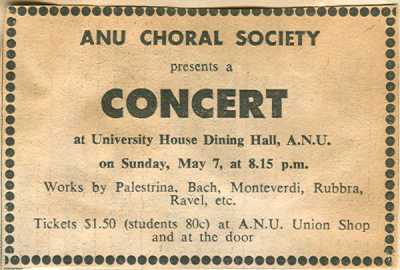

SCUNA history » Concerts » 1972 - 1

ANU CHORAL SOCIETY
presents a
CONCERT
at University House Dining Hall, A.N.U.
on Sunday, May 7, at 8.15 p.m.
Works by Palestrina, Bach, Monteverdi, Rubbra,
Ravel, etc.
Tickets $1.50 (students 80c) at A.N.U. Union Shop
and at the door
My thanks to Deborah Martin for providing a scan of this item.
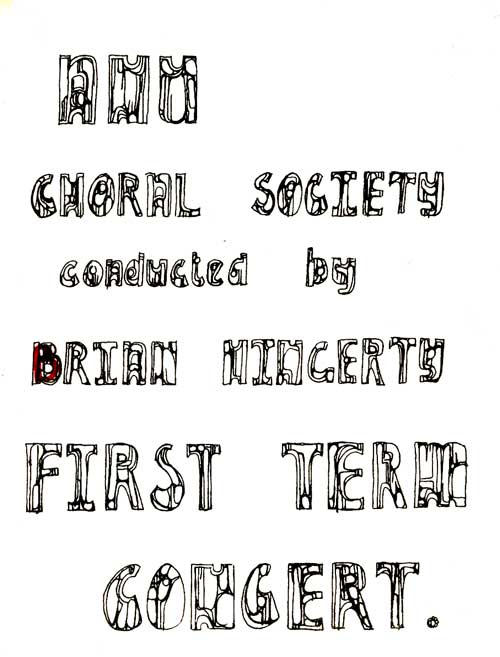
ANU
CHORAL SOCIETY
conducted by
BRIAN HINGERTY
FIRST TERM
CONCERT.
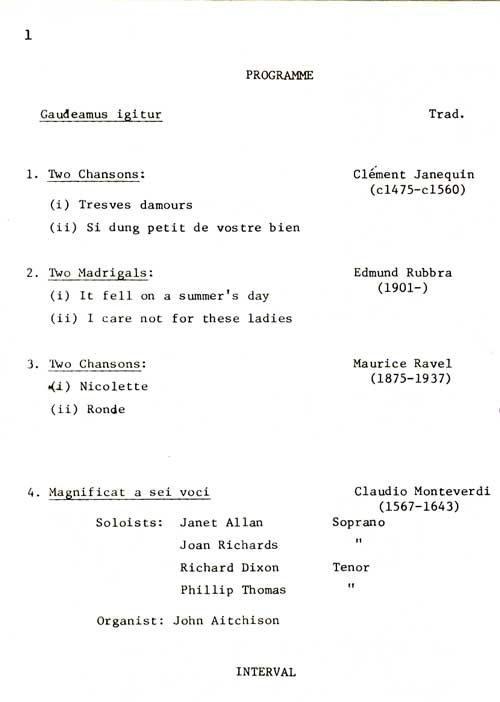
| PROGRAMME | |||||
| Gaudeamus Igitur | Trad. | ||||
| 1. | Two Chansons: | Clément Janequin (c1475-c1560) |
|||
| (i) | Tresves damours | ||||
| (ii) | Si dung petit de vostre bien | ||||
| 2. | Two Madrigals: | Edmund Rubbra (1901-) |
|||
| (i) | It fell on a summer's day | ||||
| (ii) | I care not for these ladies | ||||
| 3. | Two Chansons: | Maurice Ravel (1875-1937) |
|||
| (i) | Nicolette | ||||
| (ii) | Ronde | ||||
| 4. | Magnificat a sei voci: | Claudio Monteverdi (1567-1643) |
|||
| Soloists: | Janet Allan | Soprano | |||
| Joan Richards | " | ||||
| Richard Dixon | Tenor | ||||
| Phillip Thomas | " | ||||
| Organist: | John Aitchison | ||||
| INTERVAL | |||||

| 5. | Missa Papae Marcelli | G.P. da Palestrina (1525-1594) |
||
| Kyrie | ||||
| Gloria | ||||
| Credo | ||||
| Sanctus/Benedictus/Osanna | ||||
| Agnus Dei | miserere nobis | |||
| Agnus Dei | dona nobis pacem | |||
| 6. | Cantata No. 4 "Christ lag In Todesbanden" |
J. S. Bach (1685-1750) |
||
| Sinfonia: | ||||
| Verse I: | Chorus | |||
| Verse II: | Duet, Soprano and Alto | |||
| Verse III: | Tenor | |||
| Verse IV: | Chorus | |||
| Verse V: | Bass | |||
| Verse VI: | Duet, Soprano and Tenor | |||
| Verse VII: | Chorale | |||
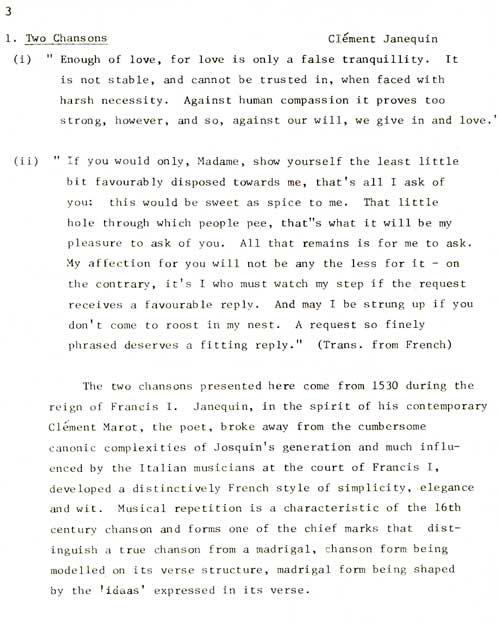
l. Two Chansons Clément Janequin
(i) " Enough of love, for love is only a false tranquillity. It is not stable, and cannot be trusted in, when faced with harsh necessity. Against human compassion it proves too strong, however, and so, against our will, we give in and love."
(ii) " If you would only, Madame, show yourself the least little bit favourably disposed towards me, that's all I ask of you: this would be sweet as spice to me. That little hole through which people pee, that's what it will be my pleasure to ask of you. All that remains is for me to ask. My affection for you will not be any the less for it - on the contrary, it's I who must watch my step if the request receives a favourable reply. And may I be strung up if you don't come to roost in my nest. A request so finely phrased deserves a fitting reply."
(Trans. from French)
The two chansons presented here come from 1530 during the reign of Francis I. Janequin, in the spirit of his contemporary Clement Marot, the poet, broke away from the cumbersome canonic complexities of Josquin's generation and much influenced by the Italian musicians at the court of Francis I, developed a distinctively French style of simplicity, elegance and wit. Musical repetition is a characteristic of the 16th century chanson and forms one of the chief marks that distinguish a true chanson from a madrigal, chanson form being modelled on its verse structure, madrigal form being shaped by the 'ideas' expressed in its verse.
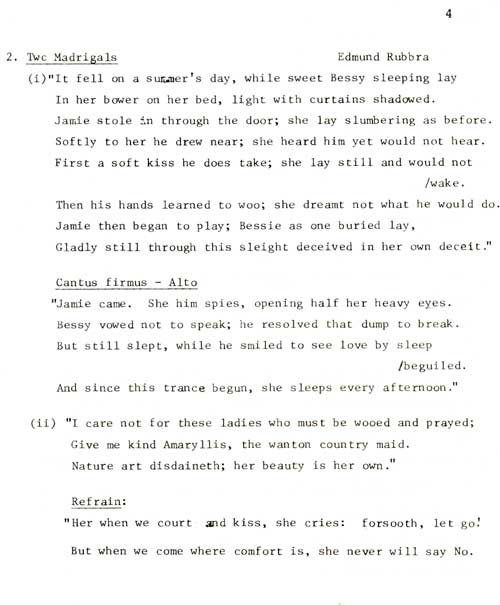
2. Two Madrigals Edmund Rubbra
(i) "It fell on a summer's day, while sweet Bessy sleeping lay
In her bower on her bed, light with curtains shadowed.
Jamie stole in through the door; she lay slumbering as before.
Softly to her he drew near; she heard him yet would not hear.
First a soft kiss he does take; she lay still and would not wake.
Then his hands learned to woo; she dreamt not what he would do.
Jamie then began to play; Bessie as one buried lay,
Gladly still through this sleight deceived in her own deceit."
Cantus firmus -- Alto
"Jamie came. She him spies, opening half her heavy eyes.
Bessy vowed not to speak; he resolved that dump to break.
But still slept, while he smiled to see love by sleep beguiled.
And since this trance began, she sleeps every afternoon."
(ii) "I care not for these ladies who must be wooed and prayed;
Give me kind Amaryllis, the wanton country maid.
Nature art disdaineth; her beauty is her own."
Refrain:
"Her when we court and kiss, she cries: forsooth, let go!
But when we come where comfort is, she never will say No.
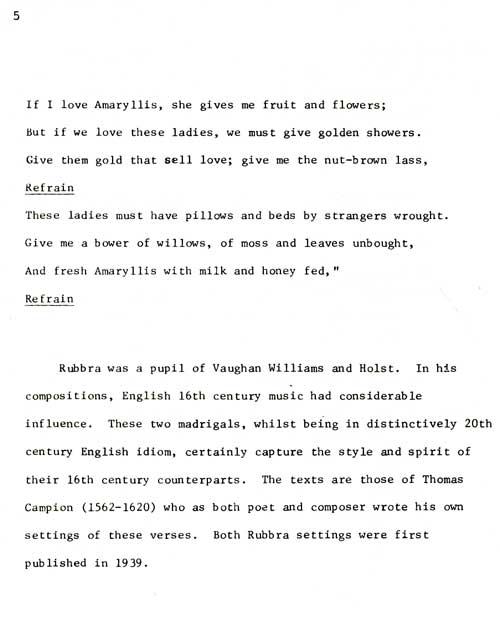
If I love Amaryllis, she gives me fruit and flowers;
But if we love these ladies, we must give golden showers.
Give them gold that sell love; give me the nut-brown lass,
Refrain
These ladies must have pillows and beds by strangers wrought.
Give me a bower of willows, of moss and leaves unbought,
and fresh Amaryllis with milk and honey fed."
Refrain
Rubbra was a pupil of Vaughan Williams and Holst. In his compositions, English 16th century music had considerable influence. These two madrigals, whilst being in distinctively 20th century English idiom, certainly capture the style and spirit of their 16th century counterparts. The texts are those of Thomas Campion (1562-1620) who as both poet and composer wrote his own settings of these verses. Both Rubbra settings were first published in 1939.
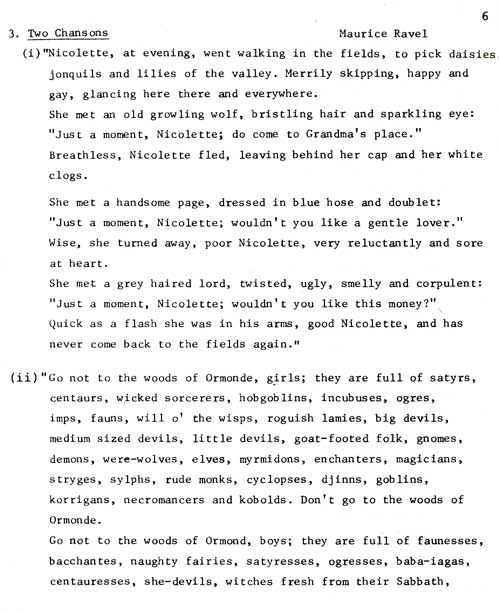
3. Two Chansons Maurice Ravel
(i) "Nicolette, at evening, went walking in the fields, to pick daisies jonquils and lilies of the valley. Merrily skipping, happy and gay, glancing here there and everywhere.
She met an old growling wolf, bristling hair and sparkling eye: "Just a moment, Nicolette; do come to Grandma's place." Breathless, Nicolette fled, leaving behind her cap and her white clogs.
She met a handsome page, dressed in blue hose and doublet: "Just a moment, Nicolette; wouldn't you like a gentle lover." Wise, she turned away, poor Nicolette, very reluctantly and sore at heart.
She met a grey haired lord, twisted, ugly, smelly and corpulent: "Just a moment, Nicolette; wouldn't you like this money?" Quick as a flash she was in his arms, good Nicolette, and has never come back to the fields again."
(ii) "Go not to the woods of Ormonde, girls; they are full of satyrs, centaurs, wicked sorcerers, hobgoblins, incubuses, ogres, imps, fauns, will o' the wisps, roguish lamies, big devils, medium sized devils, little devils, goat-footed folk, gnomes, demons, were-wolves, elves, myrmidons, enchanters, magicians, stryges, sylphs, rude monks, cyclopses, djinns, goblins, korrigans, necromancers and kobolds. Don't go to the woods of Ormonde.
Go not to the woods of Ormond, boys; they are full of faunesses, bacchantes, naughty fairies, satyresses, ogresses, baba-iagas, centauresses, she-devils, witches fresh from their Sabbath,
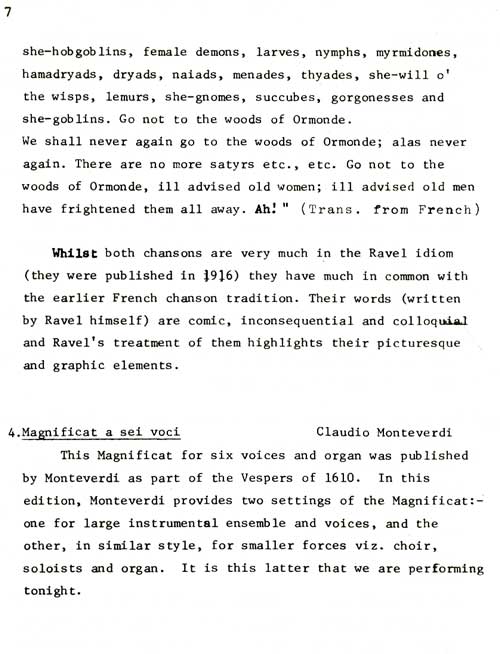
she-hobgoblins, female demons, larves, nymphs, myrmidones, hamadryads, dryads, naiads, menades, thyades, she-will o' the wisps, lemurs, she-gnomes, succubes, gorgonesses and she-goblins. Go not to the woods of Ormonde.
We shall never again go to the woods of Ormonde; alas never again. There are no more satyrs etc., etc. Go not to the woods of Ormonde, ill advised old women; ill advised old men have frightened them all away. Ah!"
(Trans. from French)
Whilst both chansons are very much in the Ravel idiom (they were published in 1916) they have much in common with the earlier French chanson tradition. Their words (written by Ravel himself) are comic, inconsequential and colloquial and Ravel's treatment of them highlights their picturesque and graphic elements.
4. Magnificat a sei voce Claudio Monteverdi
This Magnificat for six voices and organ was published by Monteverdi as part of the Vespers of 1610. In this edition, Monteverdi provides two settings of the Magnificat:- one for large instrumental ensemble and voices, and the other, in similar style, for smaller forces viz. choir, soloists and organ. It is this latter that we are performing tonight.
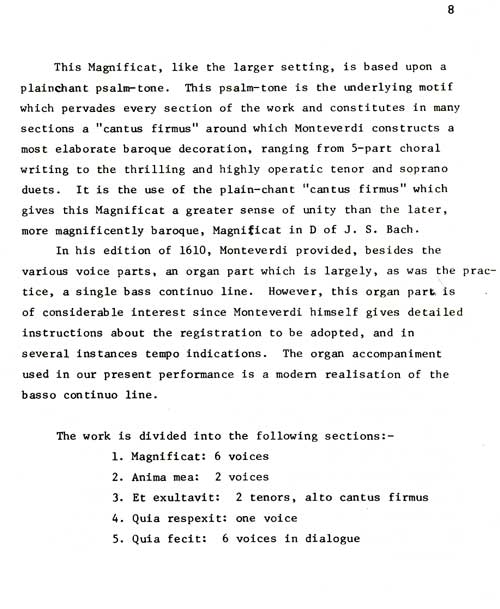
This Magnificat, like the larger setting, is based upon a plainchant psalm-tone. This psalm-tone is the underlying motif which pervades every section of the work and constitutes in many sections a "cantus firmus" around which Monteverdi constructs a most elaborate baroque decoration, ranging from 6-part choral writing to the thrilling and highly operatic tenor and soprano duets. It is the use of the plain-chant "cantus firmus" which gives this Magnificat a greater sense of unity than the later, more magnificently baroque, Magnificat in D of J. S. Bach.
In his edition of 16l0, Monteverdi provided, besides the various voice parts, an organ part which is largely, as was the practice, a single bass continuo line. However, this organ part is of considerable interest since Monteverdi himself gives detailed instructions about the registration to be adopted, and in several instances tempo indications. The organ accompaniment used in our present performance is a modern realisation of the basso continuo line.
The work is divided into the following sections:-
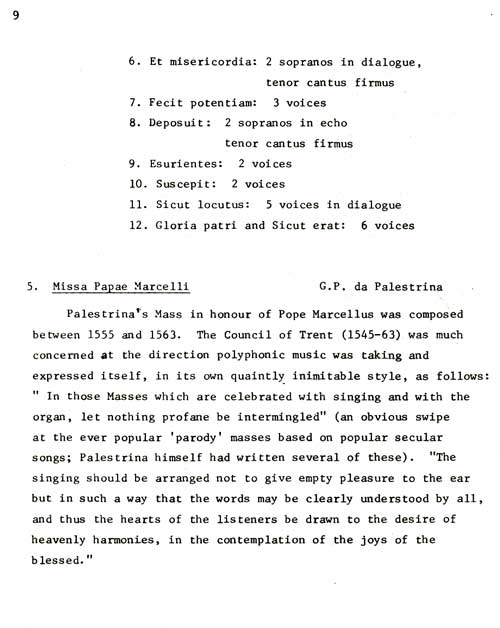
5. Missa Papae Marcelli G.P. da Palestrina
Palestrina's Mass in honour of Pope Marcellus was composed between 1555 and 1563. The Council of Trent (1545-63) was much concerned at the direction polyphonic music was taking and expressed itself, in its own quaintly inimitable style, as follows:
"In those Masses which are celebrated with singing and with the organ, let nothing profane be intermingled" (an obvious swipe at the ever popular 'parody' masses based on popular secular songs; Palestrina himself had written several of these). "The singing should be arranged not to give empty pleasure to the ear but in such a way that the words may be clearly understood by all, and thus the hearts of the listeners be drawn to the desire of heavenly harmonies, in the contemplation of the joys of the blessed."

Because, in the polyphonic settings of the Mass, the words were becoming lost in the contrapuntal maze, it was proposed to ban from the Church use the polyphonic style. Palestrina is said to have composed the Missa Papae Marcelli to prove to the Council Fathers that whilst retaining the polyphonic style, the words could indeed be given their due prominence. Whilst it is certainly not true that this Mass "saved" contrapuntal music, nonetheless this Mass was one of the arguments that persuaded the Council against banning such music.
The work is largely written for 6 voices. However, the quot;Crucifixus" of the Credo and the Benedictus are for 4 voices, and the final Agnus Dei is for 7 voices.
Whilst the music of Palestrina probably surpasses that of all his contemporaries by reason of its classical restraint, its noble simplicity, its intense devotion and its flawless contrapuntal technique, one will seek in vain for any of the word-painting of Lassus or any of the vivid colouristic effects that one finds in the Gabrielis, in this Missa Papae Marcelli. The texture, despite the large number of voices is clear and uncluttered by prolonged melismatic figures. Words are not repeated to fit the logic of the musical phrase; where this does occur, as in the Agnus Dei, the repetition serves to enhance the reflective nature of the section.
The Missa Papae Marcelli is certainly Palestrina's most important achievement and must rank as the most splendid musical feat of the l6th century.
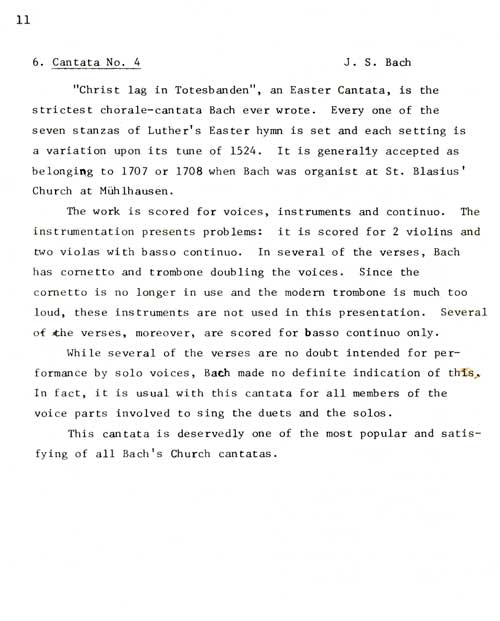
6. Cantata No. 4 J. S. Bach
"Christ lag in Totesbanden", an Easter Cantata, is the strictest chorale-cantata Bach ever wrote. Every one of the seven stanzas of Luther's Easter hymn is set and each setting is a variation upon its tune of 1524. It is generally accepted as belonging to 1707 or 1708 when Bach was organist at St. Blasius' Church at Muhlhausen.
The work is scored for voices, instruments and continuo. The instrumentation presents problems: it is scored far 2 violins and two violas with basso continuo. In several of the verses, Bach has cornetto and trombone doubling the voices. Since the cornetto is no longer in use and the modern trombone is much too loud, these instruments are not used in this presentation. Several of the verses, moreover, are scored for basso continuo only.
While several of the verses are no doubt intended for performance by solo voices, Bach made no definite indication of this. In fact, it is usual with this cantata for all members of the voice parts involved to sing the duets and the solos.
This cantata is deservedly one of the most popular and satisfying of all Bach's Church cantatas.
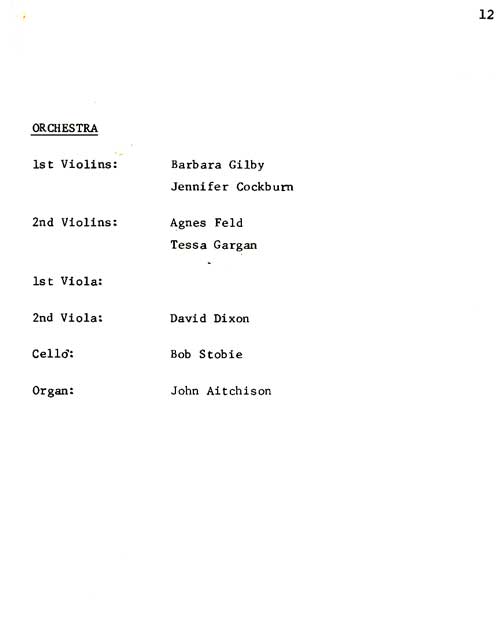
| ORCHESTRA | |
| 1st Violins: | Barbara Gilby Jennifer Cockburn |
| 2nd Violins: | Agnes Feld Tessa Gargan |
| 1st Viola: | |
| 2nd Viola: | David Dixon |
| Cello: | Bob Stobie |
| Organ: | John Aitchison |
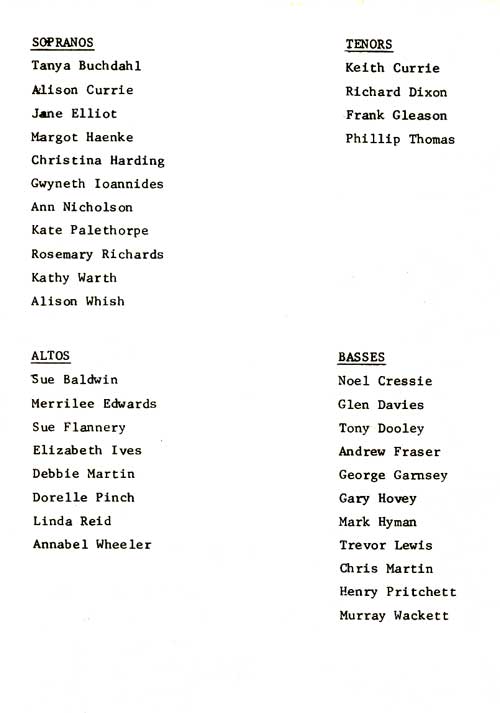
| SOPRANOS | TENORS |
| Tanya Buchdahl Alison Currie Jane Elliot Margot Haenke Christina Harding Gwyneth Ioannides Ann Nicholson Kate Palethorpe Rosemary Richards Kathy Warth Alison Whish |
Keith Currie Richard Dixon Frank Gleason Phillip Thomas |
| ALTOS | BASSES |
| Sue Baldwin Merrilee Edwards Sue Flannery Elizabeth Ives Debbie Martin Dorelle Pinch Linda Reid Annabel Wheeler |
Noel Cressie Glen Davies Tony Dooley Andrew Fraser George Garnsey Gary Hovey Mark Hyman Trevor Lewis Chris Martin Henry Pritchett Murray Wackett |